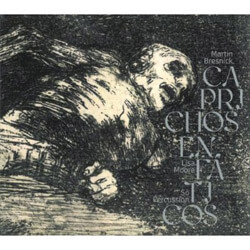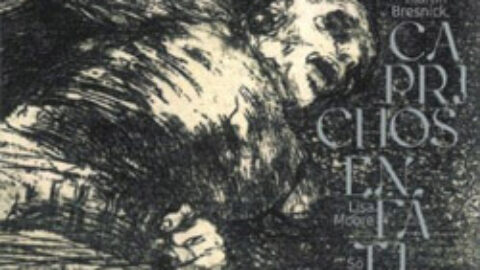 Francisco Goya’s famous series of prints Los Desastres de la Guerra (The Disasters of War) were created between 1810 and 1820, though not actually published until 35 years after Goya’s death, in 1863. There are 82 prints in all, each highly critical of both Spanish and French rulers during the conflicts between the two countries in the early 19th century, and they are shockingly graphic: realistic depictions of mutilated corpses in the aftermath of battle and the effects of famine, and gross mockeries of the ruling classes and the clergy. They are less high art and more a sort of proto-photojournalism.
Francisco Goya’s famous series of prints Los Desastres de la Guerra (The Disasters of War) were created between 1810 and 1820, though not actually published until 35 years after Goya’s death, in 1863. There are 82 prints in all, each highly critical of both Spanish and French rulers during the conflicts between the two countries in the early 19th century, and they are shockingly graphic: realistic depictions of mutilated corpses in the aftermath of battle and the effects of famine, and gross mockeries of the ruling classes and the clergy. They are less high art and more a sort of proto-photojournalism.
Martin Bresnick’s Caprichos Enfáticos: Los Desastres de la Guerra, an 8-movement concerto for pianist Lisa Moore and Sō Percussion, begins with, of all things, a farandole/farándula––a popular, jaunty 6/8 chain dance. In live performance, Lisa Moore plays the opening line of the farandúla on xylophone, alone on stage. A percussionist enters behind her and seamlessly takes over the line, and Moore continues to the second line. A second percussionist enters, taking over the first line, and the first percussionist moves to the second line, and Moore moves to the next layer, etc. It’s torturous to try and describe the effect in words, especially since it’s been three years since I saw it live at the 2008 Canberra International Music Festival in Australia, but it really does look and feel like a musical chain dance. It’s also just really cool to watch Lisa Moore play toms.
Eventually, of course, she does end up at the piano. Farándula De Charlatanes, No Saben El Camino (Farandole Of Charlatans – They Don’t Know The Way) alternates between harsh dissonance and strange timbres (flexatone!) and a kind of offbeat march. Estragos de la Guerra (Ravages of War) makes an overt reference to Mars, from Holst’s Planets suite, with all four percussionists playing in unison on large drums. As that famous rhythm grows and morphs into a torrent of martial outbursts and machine-gun barrages, the piano embeds a simple tune, starting on an open fifth and growing along with the drum-rhythm to a virtuosic and wild peak. Farándula De Políticos, Contra El Bien General (Farandole Of Politicians, Against The Common Good) is all gallows humor: long silences, a dog barking (actually a cuíca), huge shifts in register and tone, musical sarcasm. Farándula De Populacho (Farandole Of The Rabble) contrasts a low-rumbling, dissonant piano with tick-tick-boom percussion blasts (on various high unpitched pieces of wood and a large bass drum) in multiple tempos, and ends with a burst of, yes, applause: this is bread and circuses, reality TV, a monster truck rally. Church bells and whispered prayers begin ¡Extraña Devoción! (Strange Devotion!); a simple, descending scalar melody in the piano gives way to something almost hymnal, but distorted, haunted.

Farándula De Creyentes, Nada. Ello Lo Dice (Farandole Of Believers, Nothing. That Is What It Says) is the dark heart of Caprichos Enfáticos, a sparse, ambient soundscape built from non-pitched percussion and lots of silence. A hymn appears briefly (that’s Lisa Moore again, this time on melodica) before being cut off by the loud, obnoxious ring of an old telephone, which itself ends abruptly, returning us to the soundscape. The hymn appears again, is cut off again by the telephone. It appears a third time, playing through and under the ringing telephone, swelling into the final movement, Farándula Doble (Farandole Double), in which the first movement’s dance music reappears on piano with the Mars-esque brutal drums and ever-increasing chaos: police whistles! cowbells! The cuíca, of course, gets the last, groaning word.
If that description sounds kitchen-sink maximalist, I promise you it’s not. Bresnick’s music always has a thrilling economy of means––not minimalist, but concise, efficient––and he is a true master of guiding a listener’s attention through long spans of time (this work is around a half-hour, but feels shorter). He does manage to cram a whole ton of instruments onto that stage, but each one has such a clear role (yes, even the cuíca) that it never becomes cluttered or overwhelming. Caprichos Enfáticos works slightly less well on CD than it does live, but only because you lose Johanna Bresnick’s video projections (based on the Goya prints) and the theatrical element of the performance. That said, couldn’t the DVD projections have been included on the CD as bonus material? The CD itself is pretty bare-bones, and doesn’t include the Goya prints the movements are based on, either. They’re readily available on Google Images, but it would have been nice to have them on the disc itself.
The recording itself sounds great, though the piano can sometimes sound a little distant when up against a battery of drums. There is a beautiful acoustic bloom on those drums, so it might just be one of the inevitable trade-offs of the recording style. I’m also not entirely convinced that that recording style (the recording as document of a live performance) was right for this piece, and wondering what a different recording style would have produced. Certain musical elements––that ringing telephone in Nada. Ello Lo Dice, the jangling metal and whispering in ¡Extraña Devoción!, and a few other small things might have actually benefited from being recorded separately and multi-tracked into the mix. It would be less “accurate,” but paradoxically more true to how those things actually worked in live performance.
I do have one other gripe. In the program note, on the inside of the CD jacket, there are two big-ol’ typos: a misspelling (“Destastres” [sic] for “Desastres”) and a grammatical error (amazingly, “it’s” for “its”). Does nobody hire proofreaders* anymore? Those are pretty easy typos to spot––I caught them at first glance––and there’s really no reason why they shouldn’t have been caught, especially given how little text there is in the packaging.
Despite all that, the performances are as amazing as you’d expect from these players, and the piece is fun, darkly funny, witty, and unexpectedly moving (as you’d expect from this composer).
*Shameless self-promotion: I’m a proofreader. I’ll do it.
Martin Bresnick, Lisa Moore, So Percussion Caprichos Enfaticos (Cantaloupe, released October 25, 2011) – Buy on Amazon
—
Jeremy Howard Beck is a New York-based composer, as well as an active trombonist. Follow him on Twitter: @jeremyhowardboo
























